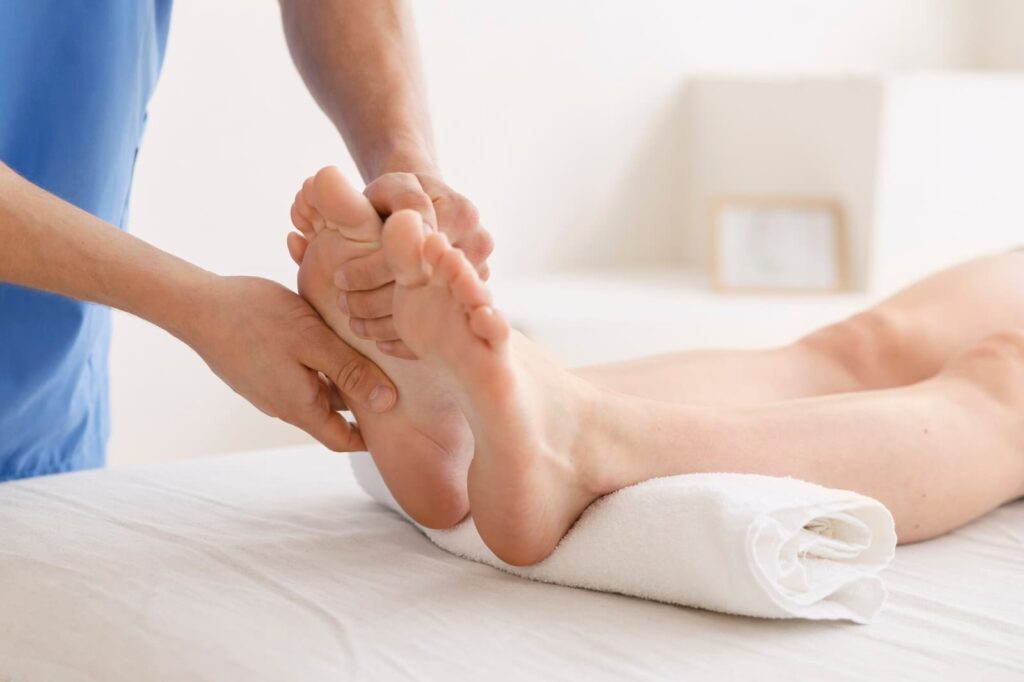Morton’s neuroma is a painful condition that affects the plantar digital nerves in the foot, often causing discomfort and difficulty with walking. Understanding the signs and symptoms of this condition is crucial for early detection and effective management.
Key Questions Addressed in this Article:
- What exactly is Morton’s Neuroma, and what are the factors contributing to its development?;
- What are the causes and risk factors associated with Morton’s Neuroma?;
- What are the common symptoms of Morton’s Neuroma?;
- How is Morton’s Neuroma diagnosed, and what are the differential diagnoses to consider?;
- What are the treatment options available for Morton’s Neuroma?;
- What can happen if Morton’s Neuroma is ignored?;
- How can Morton’s Neuroma be prevented?;
- Why is early recognition and management of Morton’s Neuroma important for foot health and mobility?
What is Morton’s Neuroma?
Morton’s neuroma develops in the plantar digital nerves that run between the long bones of the foot. The condition arises due to compression and friction trauma on the surrounding tissue, leading to chronic thickening and swelling of the nerve lining located between the toes. This thickened bulbus in the inflamed nerve is known as Morton’s neuroma, typically causing pain in the ball of the foot. While it commonly occurs between the third and fourth toes, it can also manifest in other toe joint spaces.
Causes & Risk Factors
The primary cause of Morton’s neuroma is tight and poorly fitting footwear, particularly high heels, which irritate and compress the nerves in the feet. The pressure exerted by cramming toes into narrow or tapered toe boxes, along with the added strain from the sloping shape of high heels, contributes to nerve irritation. Foot and gait abnormalities, such as abnormal joint mobility and range of motion, can also increase pressure on the ball of the foot. Activities involving repetitive stress on the foot, like running or court sports, may further aggravate these nerves.
Symptoms
Progressive Discomfort
As Morton’s neuroma advances, the pain and discomfort can become more persistent and intense. Walking or standing for extended periods may exacerbate the symptoms, leading to aching or shooting pains in the affected area. Some individuals may notice a visible swelling or thickening between the toes, accompanied by a feeling of instability or a clicking sensation when walking.
Impact on Mobility
The presence of Morton’s neuroma can significantly impact mobility and quality of life. Individuals may find it challenging to engage in physical activities or wear certain types of footwear comfortably. The pain and discomfort associated with the condition can limit daily activities and lead to a decreased range of motion in the foot.
Diagnosis
Clinical Evaluation
Diagnosing Morton’s neuroma typically involves a thorough clinical evaluation by a healthcare provider. The medical history of the individual, including details about symptoms and potential risk factors, is assessed. A physical examination of the foot is conducted to identify areas of tenderness, swelling, or abnormal sensations. Palpation of the foot may elicit pain or a clicking sensation, providing valuable diagnostic clues.
Imaging Studies
In some cases, imaging studies such as X-rays, ultrasound, or magnetic resonance imaging (MRI) may be recommended to visualize the structures of the foot in greater detail. These imaging modalities can help confirm the presence of a Morton’s neuroma, assess its size and location, and rule out other potential causes of foot pain. Imaging findings, combined with clinical observations, aid in formulating an accurate diagnosis and treatment plan.
Differential Diagnosis
Distinguishing Morton’s neuroma from other conditions that cause foot pain is essential for appropriate management. Conditions such as metatarsalgia, stress fractures, bursitis, or arthritis can present with similar symptoms and must be considered during the diagnostic process. Healthcare providers use a combination of clinical assessment, imaging studies, and sometimes nerve conduction tests to differentiate between these conditions and ensure proper treatment.
Treatment
Conservative Approaches
Initial treatment for Morton’s neuroma often involves conservative measures aimed at alleviating symptoms and reducing nerve irritation. These approaches may include wearing supportive footwear with a wide toe box, using orthotic inserts to cushion and support the foot, and avoiding high heels or tight shoes that exacerbate discomfort. Physical therapy exercises focusing on strengthening the foot muscles and improving flexibility can also be beneficial.
Medications
In some cases, nonsteroidal anti-inflammatory drugs (NSAIDs) or corticosteroid injections may be prescribed to reduce pain and inflammation associated with Morton’s neuroma. NSAIDs help alleviate discomfort, while corticosteroid injections deliver targeted relief by reducing swelling around the affected nerve. These medications are typically used in conjunction with other conservative treatments to manage symptoms effectively.
Surgical Intervention
When conservative measures fail to provide adequate relief or if the condition progresses, surgical intervention may be considered. Surgical procedures for Morton’s neuroma aim to release pressure on the affected nerve and remove any thickened tissue causing compression. Depending on the size and location of the neuroma, surgical options may include nerve decompression, neurectomy (nerve removal), or ligament release. Surgical outcomes vary, and individuals undergoing these procedures should discuss the risks and benefits with their healthcare provider.
What Can Happen If I Ignore Morton’s Neuroma?
Progression of Symptoms
Ignoring the signs of Morton’s neuroma can lead to the progression of symptoms and worsening discomfort over time. Untreated neuromas may increase in size and become more painful, impacting daily activities and mobility. Continued pressure and irritation on the nerves can result in chronic inflammation and structural changes within the foot, potentially leading to long-term complications.
Functional Limitations
Persistent Morton’s neuroma can cause functional limitations and affect quality of life. Individuals may experience difficulty walking, standing, or participating in physical activities due to ongoing pain and discomfort. The condition can interfere with footwear choices, work responsibilities, and recreational pursuits, limiting overall mobility and independence.
Risk of Complications
Prolonged neglect of Morton’s neuroma raises the risk of developing secondary complications. Chronic nerve compression and inflammation can lead to nerve damage, altered sensation in the foot, and potential gait abnormalities. Severe cases of untreated Morton’s neuroma may require more extensive interventions and have a greater impact on foot function and overall well-being.

Prevention
Footwear Selection
Choosing appropriate footwear plays a crucial role in preventing Morton’s neuroma. Opt for shoes with a roomy toe box that allows for natural toe splay and minimizes pressure on the forefoot. Avoid high heels or shoes with narrow, pointed toe boxes that compress the toes and increase the risk of nerve irritation. Selecting supportive footwear with adequate cushioning and arch support can help maintain foot health and reduce the likelihood of developing neuromas.
Foot Care Practices
Practicing good foot hygiene and care can contribute to overall foot health and reduce the risk of neuroma development. Keep feet clean and dry, trim toenails properly to prevent ingrown nails, and inspect the feet regularly for any signs of irritation or injury. Maintaining a healthy weight, engaging in regular physical activity, and stretching the feet and lower limbs can also promote foot health and minimize the impact of biomechanical stressors on the feet.
Conclusion
In conclusion, recognizing the signs and symptoms of Morton’s neuroma and heel pain is essential for timely diagnosis and effective treatment. By understanding the causes, risk factors, symptoms, diagnostic approaches, treatment options, potential consequences of neglecting the condition, preventive measures, and the importance of proactive foot care, individuals can take proactive steps to maintain foot health and mobility.


